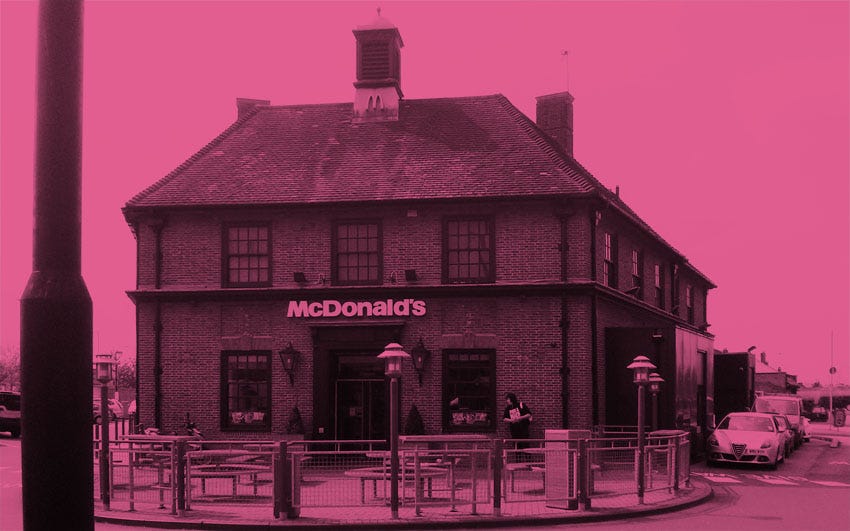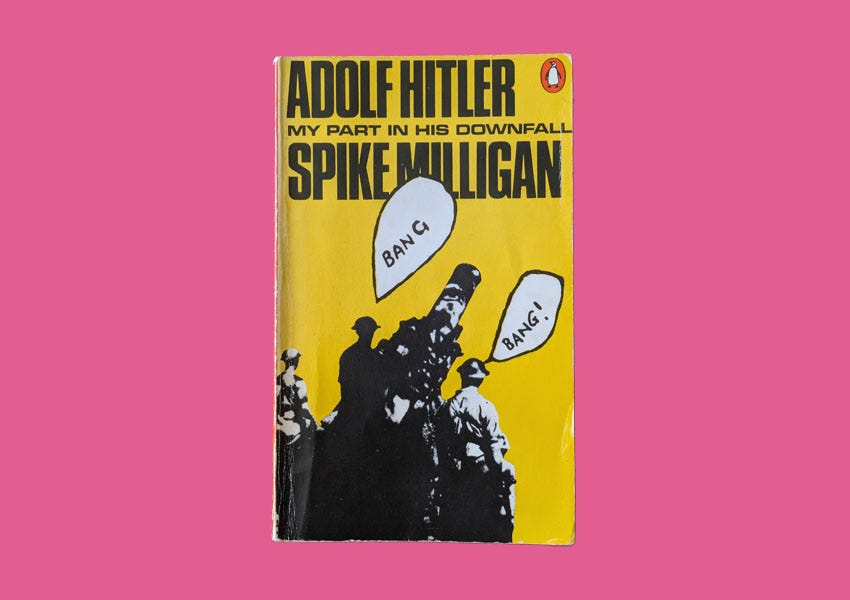Pub crawling as a way to practice psychogeography
There are few better ways to get to know a town or city than to go on a pub crawl with your eyes and brain engaged.
Psychogeography is the exploration of towns and cities while reflecting on the meaning and stories held in their buildings and streets.
It’s also sometimes derided as a pretentious way to describe going for a bit of a wander about.
We don’t own a car and tend to walk everywhere, cycle (Jess), or use public transport. In fact, our shared love of using our feet to get from A to B was part of what brought us together more than 25 years ago.
Our absolute favourite thing to do on a city break is pick a destination and schlep there, along canal paths or through backstreets. Probably finishing with a beer.
Birmingham to Wolverhampton is a good one. Stockport to Manchester is another. You cross borders from industrial zones into working class neighbourhoods, from middle class enclaves into post-war estates, and from business districts into landscapes defined by waterways or railways.
But it was while researching our 2017 book 20th Century Pub that we really started to think of what we were doing as maybe a bit psychogeography-ish.
Jess has always been a map lover and got really into reading urban landscapes. It got to the point where she could easily say: “I bet there's an interwar pub on that junction.” And she’d be right.
Looking for pubs – trading, converted, vanished – took us on wanders through the edgelands of West London, Wythenshawe, Hartlepool, Bournville, Bellingham, Birkenhead, Harlow, Stevenage…
We ended up in lots of places we wouldn’t otherwise have visited, looking at much more besides pubs.
We have particularly fond memories of standing on a busy junction in Eltham, South London, taking photographs of a McDonald’s that we'd spent hours walking to. It’s the one pictured at the top of this newsletter.
It was built as The Yorkshire Grey on farmland in the 1920s, to serve the new Middle Park housing estate. That it had become a fast food restaurant by 2014 tells a four-dimensional story about Britain.
To understand pubs and their place in the landscape you also need to understand how towns develop. Old town, new town, ring road, slum clearances, tower blocks, estates, railways, canals… pubs either stud these spaces, or are noticeably absent from them.
Some notable psychogeography practitioners also happen to be keen on pubs. John Rogers, a YouTuber and the author of This Other London, often pauses to look at pubs on his rambles, and often finishes his walk in the pub.
And many beer writers and bloggers take a psychogeographic approach, whether consciously or not.
Martin Taylor’s posts often include details of the journey to the pub with wry and sometimes snarky commentary on the towns he visits. Like this piece on Gosport, for example, loaded with photos of street furniture and signs.
Will Hawkes’s monthly newsletter, London Beer City, is about London as much as it is about beer. His recent piece about The Old Kent Road felt like pure psychogeography to us. See also: Mark Johnson, Eoghan Walsh, and others.
One criticism of psychogeography is that it’s not inclusive. You need to be able to walk long distances for one thing, which excludes people with disabilities.
And, of course, it’s more popular with men than women, and especially with white men. (See the list of names above.)
Walking up alleyways, through industrial zones, on canal paths, and between tower blocks on council estates can feel risky at the best of times. That’s even more likely to be the case if you’re a lone woman, or from an ethnic minority group.
The easiest way to dip your toe into the psychogeographical approach to pub crawling is to identify a manageable run of pubs and amble between them, resisting the urge to jump on a bus or call an Uber.
Then, as you wander:
look out for closed pubs and spaces where pubs ought to be
use historic maps to understand how the streets have evolved
look out for clues about when the neighbourhood was built up such as postboxes, street names and founding stones
bring along an old guidebook to see what’s changed
observe the people and communities you see
look out for infrastructure like railway lines and canals
take note of pub names which often speak to lost landscapes and industries
look out for social clubs that were once attached to factories
consider how post-war rebuilding might have changed street patterns
take photos of anything and everything that catches your eye
For us, this kind of thing turns a walk into a couple of hours of reflective entertainment. It gets our brains going and, crucially, gives us something to talk about in the pubs we visit along the way.
If you want to read more about psychogeography we’d recommend this article by Siobhan Lyons at The Conversation.
Spike Milligan on the 20th century pub
We mentioned The Yorkshire Grey above which also happens to feature in Adolf Hitler: my part in his downfall. It’s a comic memoir by Spike Milligan published in 1971, about his time in the British Army during World War II. Right at the start, he is trying to avoid being called up to serve:
“It was now three months since my call-up. To celebrate I hid under the bed dressed as Florence Nightingale. Next morning I received a card asking me to attend a medical at the Yorkshire Grey, Eltham.”
This is not the only pub in the book, however. Though later better known as a comedian, via The Goon Show, Milligan was also a jazz musician. As a soldier, he made money on the side performing with a band, often in pubs.
He describes a pub in Eastbourne like this:
The customers were all squaddies and their girls. The music was supplied by three elderly gentlemen on a small rostrum. Piano, violin and cello. They made desperate attempts to be ‘with it’ by playing ‘In the Mood’, ‘Beat me daddy eight to the Bar’ etc., but one felt that death was nigh…
Milligan and his band convince the landlord to give them a gig, which is a little too eventful:
The pub was really full, people passing heard the Jazz and of course came in. The landlord was delighted. Never had such a crowd. People were standing jammed against the walls… Bang. Bang. Bang. Three shots rang out, a woman screamed. Bang. The wall mirror behind me shattered. There was a struggle going on in the entrance door. More women screamed (it might have been men but I didn't have time to check). Bang again, and I hear a projectile whizz past me and thud into the wall behind. It was a Scottish Tank Gunner, who had been thrown out because of offensive behaviour. Outside he drew his pistol and fired through the door. He had tried to get in, but a French Canadian soldier grabbed his pistol arm, and was now holding it pointed to the ceiling. This all happened in a flash. Recalling the heroism of the ship's orchestra on the Titanic, I went on playing. Turning round, I discovered that neither Edgington, Fildes nor Kidgell had heard of the Titanic affair and had gone… The offending soldier was finally disarmed; the Military Police arrived and took him away.
This is interesting to us because it’s a reminder that pubs have always been (euphemism incoming) ‘lively’ places – and that wartime only made them more so.
There’s a lovely follow up to this anecdote which if we’d known about it a few years ago would certainly have been quoted in 20th Century Pub:
I visited the pub about three years ago. The place had been tarted up and Watneyised. The old landlord was gone. No one remembered him, nor the gunfight. The rostrum and the old piano were there. I went over and touched the keyboard. It was like patting an old horse you once knew.
On the blog
We had a fairly busy month on the blog with quite a few substantial posts, perhaps because we had lots of fresh input to process.
We started with a write-up of our visit to The Square & Compass in the Dorset countryside, which we found utterly charming. What we hadn’t appreciated was that it’s also one of the only five pubs to have been in every edition of the CAMRA Good Beer Guide. What are the chance of it ever coming out, we wonder? Who’d want to take responsibility for that decision.
We also (sort of) did the East Bristol Brewery Trail on a quiet, grey Saturday, observing the various taprooms in their natural state: “On the last EBBT weekend, at the start of May, we were in town and observed it from afar… There were crowds piling up on the pavement around the railway arches near Temple Meads station and herds of tipsy people wandering through the residential streets of the Dings and the industrial estates of St Philips…”
After Ray wrote about a famous font (lettering style) on his own blog Nick Stone got in touch to share high quality scans of two Watney’s brewer brand manuals. This prompted us to put together a piece answering a question that is genuinely ‘frequently asked’: what is the Watney’s font? The short answer is, there are several, and some of them are available as modern digital fonts.
Last weekend we visited St Fagans Museum near Cardiff to see The Vulcan, a relocated city centre pub that is now an exhibit. Does relocating pubs to museums work? Based on this experience, yes – and it’s certainly preferable to it being demolished altogether. An interesting footnote is that a (slightly grumpy) commenter popped up to tell us what we’d been drinking wasn’t cask ale, and that there’s been all sorts of politics over this. It’s even in the FAQ on the St Fagans website (PDF). This goes to show that (a) fake handpumps might confuse consumers, because they confused us; and (b) in a blind test even fairly experience ale drinkers (hello) might not be able to tell the difference.
Then last week we dug into the claim that avens, a type of weed that happens to grow in our garden, was supposedly a key ingredient in beer from Augsburg. We read some old books and aske our pal Andreas Krennmair for his opinion.
There were also weekly editions of ‘News, nuggets and longreads’ – a round-up of beer writing which is our contribution to keeping the scene, such as it is, alive.
And on Patreon we posted notes on the best beers we drank each weekend, footnotes to each of our Saturday round-ups, and some other bits and pieces. Do consider signing up!
And that’s your lot, until next month.
Byeeee!
Jess & Ray






Great article. The Yorkshire Grey was a blast from the past. Huge pub with an attached function room to the right where they held unlicensed boxing matches. It was thriving in the 70s and 80s. I’ve drunk in the Square and Compasses too. Both times I was there they had very classy American music. Apparently there’s a word of mouth thing where US performers recommend the place to one another as a great holiday stop when they’re in the UK. They send the landlord a YouTube link and if they’re up to scratch the pub picks them up at the station and feeds and accommodates them. It clearly works. For an off the beaten track they punch well above their weight for entertainment.